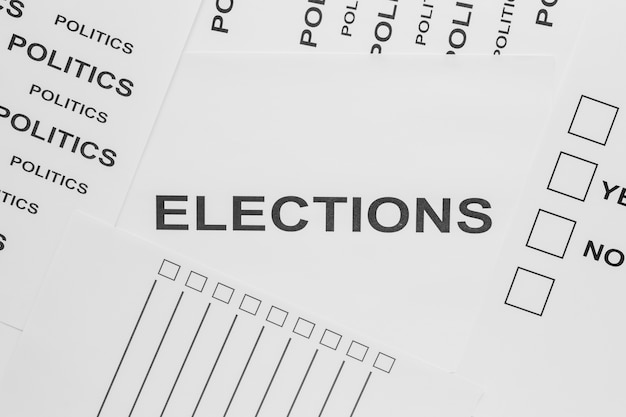2025 Election Cybersecurity: Spotting and Reporting Disinformation

2025 Election Cybersecurity is critical, learn how to identify disinformation tactics, understand fact-checking resources, and report suspicious content to safeguard the integrity of the election process and ensure informed voter participation.
With the 2025 elections on the horizon, understanding and mitigating **2025 Election Cybersecurity: How to Spot and Report Disinformation** is more critical than ever. Misinformation and disinformation campaigns can significantly impact voter perception and the democratic process.
Understanding the Threat Landscape of Election Disinformation
The spread of disinformation poses a significant threat to the integrity of elections. Understanding the different types of disinformation and how they are disseminated is crucial for staying informed and prepared.
Disinformation can take many forms, from fabricated news articles and manipulated images to coordinated social media campaigns. Recognizing these tactics is the first step in combating their impact.
Types of Election Disinformation
Election disinformation can be categorized into several types, each designed to manipulate public opinion in different ways.
- False or Fabricated News: Completely made-up stories presented as genuine news reports.
- Manipulated Media: Altering existing images or videos to change their original meaning.
- Disinformation Campaigns: Coordinated efforts to spread false or misleading information through various channels.
- Satire or Parody Presented as Fact: Content designed for humor that is mistaken for real news.
Common Tactics Used to Spread Disinformation
Disinformation is often spread using sophisticated techniques, capitalizing on social media algorithms and emotional biases.
- Social Media Bots: Automated accounts used to amplify disinformation and create a false sense of popularity.
- Troll Farms: Organized groups of individuals who spread disinformation and harass opposing viewpoints.
- Deepfakes: AI-generated videos or audio recordings that convincingly impersonate real people.
- Microtargeting: Targeting specific groups with tailored disinformation based on their demographics and interests.

By understanding these tactics, individuals can become more adept at recognizing and avoiding disinformation. Staying vigilant and critically evaluating the information consumed are essential steps in protecting the integrity of the 2025 elections.
Key Indicators of Disinformation
Recognizing disinformation requires a keen eye and a critical mindset. By understanding the telltale signs of false or misleading information, individuals can better protect themselves and others from its influence.
There are several indicators that can help identify potential disinformation. These signs often involve scrutiny of the source, the content itself, and the way it is presented.
Checking the Source
The credibility of the source is a primary factor in determining the reliability of information. Investigate the source’s reputation and history.
- Unfamiliar Website: Be wary of websites with unusual domain names or those that lack contact information.
- Lack of Transparency: Check if the source clearly identifies its authors, editors, and funding sources.
- Bias or Agenda: Assess whether the source has a known political bias or a hidden agenda that could influence its reporting.
Examining the Content
The content itself often contains clues that can indicate whether it is truthful or misleading. Look for inconsistencies and logical fallacies.
- Sensational Headlines: Be suspicious of articles with overly dramatic or emotionally charged headlines.
- Lack of Evidence: Verify that the information is supported by credible evidence, such as data, expert opinions, or official sources.
- Poor Grammar and Spelling: Disinformation often contains grammatical errors and typos, indicating a lack of editorial oversight.
Cross-Referencing Information
Always cross-reference information with other reliable sources to verify its accuracy. Multiple independent sources should corroborate the same facts.
- Consult Reputable News Outlets: Check if the information is reported by well-known and respected news organizations.
- Use Fact-Checking Websites: Consult fact-checking websites like Snopes or PolitiFact to see if the claims have been verified.
- Seek Expert Opinions: Consult experts in the field to get their perspective on the validity of the information.
By employing these strategies, individuals can become more proficient at identifying disinformation and making informed decisions. Critical thinking and skepticism are powerful tools in navigating the complex information landscape.
Leveraging Fact-Checking Resources
In the fight against disinformation, fact-checking resources play a vital role in verifying the accuracy of information. These resources provide a crucial service by debunking false claims and providing reliable information to the public.
Fact-checking organizations employ rigorous methodologies to assess the truthfulness of statements made by public figures, news outlets, and social media users. They provide detailed analyses and evidence-based conclusions.
Popular Fact-Checking Websites
- Snopes: A long-standing fact-checking website that investigates urban legends, rumors, and viral claims.
- PolitiFact: A Pulitzer Prize-winning fact-checking website that focuses on political statements and promises.
- FactCheck.org: A nonpartisan organization that monitors the accuracy of claims made by political candidates and organizations.
- The Associated Press (AP) Fact Check: A fact-checking initiative by the AP that debunks false claims in real-time.
These websites offer valuable resources for consumers of news and information, helping them sift through the noise and identify credible sources.
How Fact-Checking Works
Fact-checking involves a systematic process of verifying claims and assessing their accuracy. This process typically includes the following steps:
- Identifying the Claim: Fact-checkers begin by identifying a specific claim that can be verified.
- Gathering Evidence: They gather evidence from a variety of sources, including official documents, expert interviews, and primary data.
- Analyzing the Evidence: They analyze the evidence to determine whether the claim is accurate, misleading, or false.
- Publishing the Findings: They publish their findings in a clear and accessible format, providing a detailed explanation of their reasoning.
By understanding the fact-checking process, individuals can better appreciate the rigor and credibility of these resources.
Staying informed about the latest fact-checks and using these resources proactively can help individuals avoid being misled by disinformation. Fact-checking websites are an essential tool in maintaining an informed and engaged electorate during the 2025 elections.
Reporting Disinformation: Channels and Procedures
Reporting disinformation is a crucial step in preventing its spread and mitigating its impact. By reporting suspicious content, individuals can help social media platforms and other organizations take action against those who spread false or misleading information.
There are several channels and procedures for reporting disinformation, depending on the platform or source. Understanding these mechanisms is essential for participating in the fight against disinformation.
Reporting on Social Media Platforms
Most social media platforms have mechanisms for reporting content that violates their policies, including disinformation. These tools allow users to flag suspicious posts, profiles, and advertisements.
- Facebook: Users can report posts, profiles, and groups that spread disinformation. Facebook’s fact-checking partners help identify and label false content.
- Twitter: Users can report tweets that violate Twitter’s policies, including those that spread false or misleading information about elections.
- YouTube: Users can report videos that contain disinformation or violate YouTube’s community guidelines.
- TikTok: Users can report videos that contain false or misleading information, which TikTok reviews and may remove.
Reporting to Government Agencies
In some cases, disinformation campaigns may warrant reporting to government agencies. The Federal Bureau of Investigation (FBI) and the Cybersecurity and Infrastructure Security Agency (CISA) are among the agencies that monitor and address election-related threats.
- FBI: The FBI investigates potential criminal activities related to election interference, including disinformation campaigns.
- CISA: CISA provides resources and guidance to state and local election officials on cybersecurity and disinformation issues.

By reporting disinformation through the appropriate channels, individuals can contribute to a more informed and secure election environment. Active participation in these reporting processes is vital for upholding the integrity of the democratic process.
Educating Others About Cybersecurity and Disinformation
Educating others about cybersecurity and disinformation is a critical component of protecting the integrity of the 2025 elections. By raising awareness and providing practical guidance, individuals can empower others to become more resilient to false or misleading information.
Education efforts can take many forms, from informal conversations with friends and family to organized workshops and training sessions. The goal is to equip people with the knowledge and skills they need to navigate the complex information landscape.
Starting Conversations with Friends and Family
One of the most effective ways to combat disinformation is to have open and honest conversations with friends and family members. Share tips and resources for identifying false or misleading information.
- Share Fact-Checking Resources: Provide links to reputable fact-checking websites and encourage others to use them.
- Discuss Common Disinformation Tactics: Explain the different types of disinformation and the tactics used to spread them.
- Encourage Critical Thinking: Encourage others to question the information they encounter and to think critically about its source and content.
Organizing Workshops and Training Sessions
For those who want to take a more active role, organizing workshops and training sessions can be an effective way to educate larger groups of people. These events can provide hands-on training and facilitate in-depth discussions.
- Partner with Local Organizations: Collaborate with community groups, libraries, and schools to organize events.
- Invite Cybersecurity Experts: Invite cybersecurity experts to speak at workshops and provide valuable insights.
- Offer Practical Training: Provide practical training on how to identify disinformation, use fact-checking resources, and report suspicious content.
By educating others about cybersecurity and disinformation, individuals can create a more informed and resilient community. Empowering others to think critically and protect themselves from false information is essential for safeguarding the integrity of the 2025 elections.
Staying Informed and Engaged
Remaining informed and engaged is essential for protecting the integrity of the 2025 elections. By staying up-to-date on the latest cybersecurity threats and disinformation trends, individuals can better protect themselves and others from their influence.
Staying engaged also means participating in the democratic process, including voting, volunteering, and advocating for policies that promote cybersecurity and combat disinformation.
Following Reputable News Sources
One of the best ways to stay informed is to follow reputable news sources that adhere to high journalistic standards. These sources provide accurate and reliable information, helping individuals make informed decisions.
- Major News Organizations: Subscribe to well-known and respected news organizations, such as The New York Times, The Washington Post, and The Wall Street Journal.
- Local News Outlets: Support local news outlets that provide coverage of local issues and events.
- Public Broadcasting: Tune into public broadcasting services, such as NPR and PBS, for in-depth reporting and analysis.
Engaging in Civic Activities
Engaging in civic activities is another way to stay informed and contribute to the democratic process. These activities can include volunteering for election campaigns, attending town hall meetings, and contacting elected officials.
- Volunteer for Election Campaigns: Support candidates who prioritize cybersecurity and combat disinformation.
- Attend Town Hall Meetings: Participate in town hall meetings to learn about local issues and express your views.
- Contact Elected Officials: Contact elected officials to advocate for policies that promote cybersecurity and combat disinformation.
By staying informed and engaged, individuals can actively contribute to a more secure and informed election environment. Active participation in the democratic process is essential for safeguarding the integrity of the 2025 elections and beyond.
| Key Aspect | Brief Description |
|---|---|
| 🔍 Spotting Disinformation | Check source credibility, examine content for red flags, cross-reference facts. |
| ✅ Fact-Checking Resources | Use Snopes, PolitiFact, and FactCheck.org to verify claims and debunk false info. |
| 📢 Reporting Disinformation | Report suspicious content on social media, to the FBI, or CISA. |
| 📚 Educating Others | Share tips, resources, and organize workshops to raise awareness. |
FAQ
▼
Election disinformation is false or misleading information deliberately spread to influence voters or undermine confidence in the electoral process. It can include fake news, manipulated media, and coordinated social media campaigns.
▼
Check the source’s reputation, transparency, and bias. Look for clear contact information, identified authors, and funding sources. Reputable sources have a history of accurate reporting and adhere to journalistic standards.
▼
Some reliable fact-checking websites include Snopes, PolitiFact, and FactCheck.org. These sites provide detailed analyses and evidence-based conclusions to verify claims and debunk false information.
▼
Most social media platforms have reporting mechanisms. Look for options to flag suspicious posts, profiles, or advertisements. Provide as much detail as possible when reporting, including reasons why you believe the content is false or misleading.
▼
If you encounter a deepfake, report it to the platform where you found it. Also, inform others about deepfakes and their potential to spread disinformation. Encouraging critical thinking can help prevent the spread of manipulated media.
Conclusion
As the 2025 elections approach, vigilance and informed participation are key. By understanding how to spot and report disinformation, staying informed, and educating others, we can collectively safeguard the integrity of the democratic process and ensure a more secure and informed electorate.
